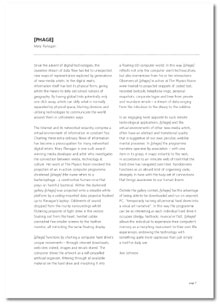 |
|||||||||
|
|
| ...Publications: Annual | ...The Physics Room Annual 2002 | ||||||||||||||
|
[PHAGE] Since the advent of digital technologies, the ceaseless stream of data flow has led to unexpected new ways of representation explored by generations of new-media artists. In the digital realm, information itself has lost its physical form, giving artists the means to defy old school notions of geography. By having global links potentially only one click away, artists can defy what is normally separated by physical space, blurring divisions and utilising technologies to communicate the world around them in unforeseen ways. The Internet and its networked wizardry comprise a virtual environment of information in constant flux. Charting these extra-ordinary flows of information has become a preoccupation for many networked digital artists. Mary Flanagan is one such award-winning media developer and artist who investigates the connection between media, technology & culture. Her work at The Physics Room involved the projection of an in-action computer programme christened [phage] (the name refers to a bacteriophage - a constructive human virus that preys on harmful bacteria). Within the darkened gallery [phage] was projected onto a sizeable white platform by a ceiling-mounted data projector hooked up to Flanagan’s laptop. Oddments of sound dropped from the murky surroundings whilst flickering pinpoints of light drew in the visitors. Snaking out from the heart, twisted cables connected five smaller screens to the mother monitor, all mimicking the same floating display. [phage] functions by charting a computer hard drive‘s unique movements - through internet downloads, web sites visited, images and emails stored. The computer drives the artwork as a self-propelled artificial organism, filtering through all available material on the hard drive and morphing it into a floating-3D-computer world. In this way [phage] reflects not only the computer user’s technoculture, but also mementoes from his or her interactions. Observers of [phage] in action at The Physics Room were treated to projected snippets of coded text, recorded birdcalls, telephone rings, personal snapshots, corporate logos and lines from private and mundane emails - a stream of data ranging from the ridiculous to the dreary to the sublime. In an engaging twist opposite to such remote technological applications, [phage] and the virtual environments of other new-media artists, often have an abstract and transitional quality that is suggestive of our own peculiar, weblike mental processes. In [phage] the programme narrative operates by association - with one item in its grasp, it snaps instantly to the next, in accordance to an intricate web of trails that the hard drive has navigated over time. Randomness functions as an absurd kind of organising code, strangely in tune with the hazy set of connections that brings awareness to our human brains. Outside the gallery context, [phage] has the advantage of being able to be downloaded and run on anyone’s PC, “temporarily turning all personal hard drives into a visual art narrative”. In this way the programme can be as interesting as each individual hard drive it occupies (dodgy, textbook, musical or flat). [phage] allows the individual to experience their computer’s memory as a morphing monument to their own life experiences, endowing the technology with something quite more capricious than just simply a tool for daily use. Jess Johnson This essay originally appeared in The Physics Room Annual 2002 Order your copy today from The Physics Room ! Related [phage] and other works by Mary Flanagan [phage]
|
||||||||||||||


